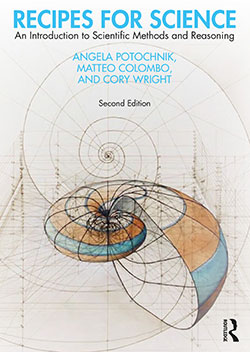

Taylor and Francis Group is part of the Academic Publishing Division of Informa PLC
This site is operated by a business or businesses owned by Informa PLC and all copyright resides with them. Informa PLC's registered office is 5 Howick Place, London SW1P 1WG. Registered in England and Wales. Number 3099067.

On this website, you can find:
Instructors of courses using this textbook may find these resources helpful at all stages of course design and implementation, from designing the syllabus to planning lectures, class activities, and exams. Instructors considering developing a new course or adopting this text may find the example syllabi to be a source of inspiration.
Students using this textbook in a course or for individual study may find the videos and additional exercises helpful in deepening their mastery of the material.
If you are using the 1st edition of the book, visit the website (link opens in new window) for resources specific to that edition, including example syllabi, slides, and additional exercises.
Scientific literacy is an essential aspect of an undergraduate education. Recipes for Science responds to this need by providing an accessible introduction to the nature of science and scientific methods appropriate for any beginning college student. The book is adaptable to a wide variety of different courses, such as introductions to scientific reasoning, methods courses in scientific disciplines, science education, and philosophy of science.
Special features of Recipes for Science include contemporary and historical case studies from many fields of physical, life, and social sciences; visual aids to clarify and illustrate ideas; text boxes to explore related topics; plenty of exercises to support student recall and application of concepts; suggestions for further readings at the end of each chapter; a glossary with helpful definitions of key terms; a companion website with course syllabi, internet resources, PowerPoint presentations, lecture notes, additional exercises, and original short videos on key topics.
. . . a wonderfully useful description of how science works. The examples are informative and effective. The exercises are imaginative, both thoughtful and thought-provoking. And the components of scientific method are clearly presented with enough detail to see not only how they work but both their strengths and limitations. All the tools are there. You probably knew what tools would be used, but with this book you will understand the variety and application with greater clarity and a better appreciation for the value of science. Recipes for Science will help you sharpen the tools and keep them sharp.
Peter Kosso, in Science & Education
More often than not students acquire content knowledge about science, deprived from any explicit reflection about the methods, the reasoning and the uncertainties that characterize it. Even laboratory activities can take the form of implementing a cookbook recipe, simply following predetermined steps towards a ‘correct’ answer. But this is not how science is done. If there are recipes, they are open to creativity, and they vary enormously. Recipes for Science excellently shows this and provides very useful materials for explicit reflection about the nature of science.
Kostas Kampourakis, University of Geneva, Switzerland
Recipes for Science is clear and very readable, providing students with a solid philosophical background in issues surrounding scientific reasoning and methodologies, fleshed out with well-chosen, compelling examples. Either on its own, or as a basis from which to build, this will be a welcome text in scientific reasoning and philosophy of science classes.
Jonathan Michael Kaplan, Oregon State University
Download How Science Works (Word 516KB)
Download Philosophy of Science for International Business and Administration (PDF 265KB)

Angela is Professor of Philosophy and Founding Director of the Center for Public Engagement with Science (link) at the University of Cincinnati. Her research focuses on science and the public, scientific explanation, how different fields of science relate to one another, and methods in population biology. She is also the author of Idealization and the Aims of Science (2017) and coedits the book series Elements in Public Engagement with Science.

Matteo is an Associate Professor at the Tilburg Center for Logic, Ethics and Philosophy of Science at Tilburg University in The Netherlands. He mainly works in the philosophy of mind and cognitive science. His current interests include issues in the foundations of theoretical neuroscience and computational approaches to psychiatric disorders.

Cory is Professor of Philosophy at California State University Long Beach. His mainly works in philosophy of science on the topics related to explanation and in metaphysics on topics related truth, facts, and judgment.